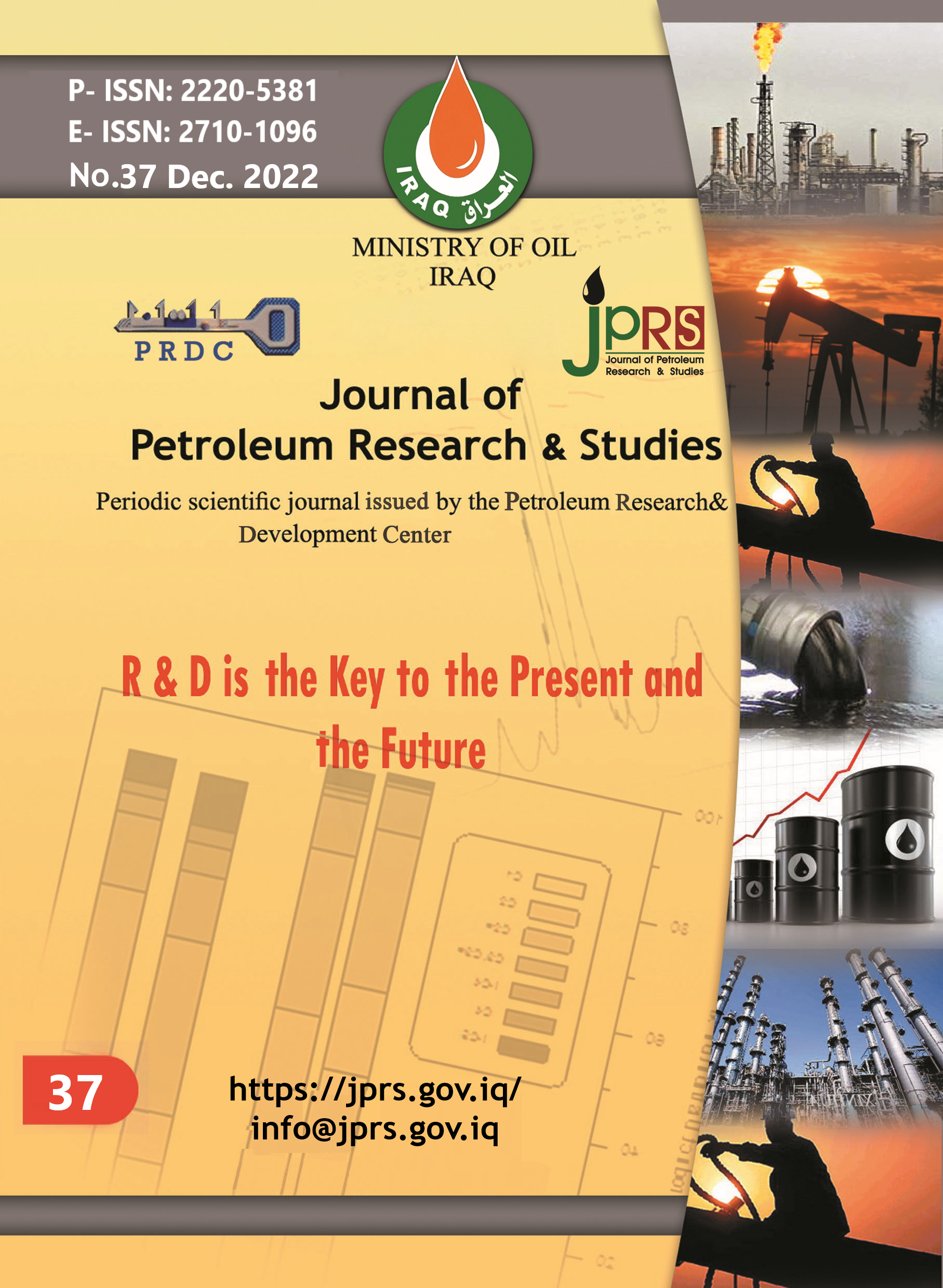Aging Effect on Rock Wettability Alteration
DOI:
https://doi.org/10.52716/jprs.v12i4.579Keywords:
Aging Effect, Wettability, Alteration, Imbibition TestAbstract
One of the factors controlling fluid distribution in porous media is wettability, which is ranging from water-wet to oil wet. Wettability could be changed due to the long-time contact with hydrocarbon liquids. Wettability alteration resulting from the aging of core samples in hydrocarbon liquids becomes a widely used technique. The aging of Core samples from different locations in different types of liquids had been studied. The aging periods used in these studies range from hours to 110 days. In this work, synthetic core samples were aged for a period ranging from 205 to 824 days into two different hydrocarbon liquids (heavy crude from the East Baghdad oil field and gas oil). Results show that long time aging periods dramatically alter wettability; also, heavy crude oil alters wettability higher than that of light hydrocarbon.
References
A. Paiaman, M. Palangar, S. Djezzar, S. Kord, “A new approach to measure wettability by relative permeability measurements,” JPSE. Journal of Petroleum Science and Engineering. 3:109191, Jul, 2021.
M. A. Fernø, M. Torsvik, S. Haugland, and A. Graue, “Dynamic laboratory wettability alteration,” EF. Energy & Fuels, 24, no. 7,3950-3958, 2010.
H. Eltoum, YL. Yang, JR. Hou, “The effect of nanoparticles on reservoir wettability alteration: a critical review,” PS. Petroleum Science, 18(1):136-53, Feb, 2021.
X. Deng, MS. Kamal, S. Patil, SM. Hussain, X. Zhou, “A review on wettability alteration in carbonate rocks: Wettability modifiers,” EF. Energy & Fuels, 4; 34(1):31-54, Dec, 2019.
N. Kumar, A. Mandal, “Wettability alteration of sandstone rock by surfactant stabilized nanoemulsion for enhanced oil recovery—A mechanistic study,” CSPEA. Colloids and Surfaces A: Physicochemical and Engineering Aspects, 20;601:125043, Sep, 2020.
J. Song, S. Rezaee, W. Guo, B. Hernandez, M. Puerto, FM. Vargas, GJ. Hirasaki, SL. Biswal, “Evaluating physicochemical properties of crude oil as indicators of low-salinity–induced wettability alteration in carbonate minerals,” SR. Scientific reports, 28;10(1):1-6, Feb, 2020.
K. Al-Garadi, A. El-Husseiny, M. Elsayed, P. Connolly, M. Mahmoud, M. Johns, A. Adebayo, “A rock core wettability index using NMR T2 measurements,” JPSE. Journal of Petroleum Science and Engineering, 1;208:109386, Jan, 2022.
A. Graue, BG. Viksund, T. Eilertsen, R. Moe, “Systematic wettability alteration by aging sandstone and carbonate rock in crude oil,” JPSE. Journal of Petroleum Science and Engineering, 1;24(2-4):85-97, Dec, 1999.
S. Sakthivel, M. Elsayed, “Enhanced oil recovery by spontaneous imbibition of imidazolium based ionic liquids on the carbonate reservoir,” JML. Journal of Molecular Liquids, 15;340:117301, Oct, 2021.
I. Torrijos, A. Mamonov, T. Puntervold, S. Strand, “The role of polar organic components in dynamic crude oil adsorption on sandstones and carbonates,” CT&F-Ciencia, Tecnología y Futuro, 10(2):5-16, Dec, 2020.
P. Viste, B. Watson, C. Nelson, M. SWACO, “The influence of wettability on return permeability,” In SPE European Formation Damage Conference & Exhibition, 2013, 5. OnePetro.
D. Kim, G. Kim, N. Chu, “Aging effect on the wettability of stainless steel,” Materials Letters, 1, 170:18-20, May, 2016.
M. Gindl, A. Reiterer, G. Sinn, SE. Tschegg, “Effects of surface ageing on wettability, surface chemistry, and adhesion of wood,” Holz als Roh-und Werkstoff, 1;62(4):273-80, Aug, 2004.
H. Khairuddin, I. Yusoff, K. Badri, S. Koting, N.Tawil, P. Ng, A. Misnon, “Effect of Aging on the Chemical, Morphological and Wettability Characteristics of Polyurethane Modified Binder,” In Advances in Civil Engineering Materials, Singapore, (pp. 261-270), Springer, 2021.
S. Sakthivel, Y. Kanj, “Spontaneous imbibition characteristics of carbon nanofluids in carbonate reservoirs,” ER. Energy Reports, 1;7:4235-48, Nov, 2021.
M. Bonto, A. Eftekhari, H. Nick, “Wettability Indicator Parameter Based on the Thermodynamic Modeling of Chalk-Oil-Brine Systems,” EF. Energy & Fuels. 10;34 (7):8018-36, Jun, 2020.
J.S. Buckly and Y. Liu, “Some mechanisms of crude oil/brine/solid interactions,” JPSE. Journal of petroleum science and engineering, 20, 155-160, 1998.
S.H. Al-Mahrooqi, C.A. Grattoni, A. H. Muggeridge and X. D. Jing, “Wettability alteration during aging: The application of NMR to monitor fluid redistribution,” SCA. Society of Core Analyst, 2005.
M. Mohammed, T. Babadagli,“A comprehensive review of material/methods and testing the selected ones on heavy-oil containing oil-wet systems,” ACIS. Adv. Colloid Interface Sci. 220, 54-77, 2015.
M. Amirpour, S. R. Shadizadeh, H. Esfandyari, S. Ahmadi, “Experimental investigation of wettability alteration on residual oil saturation using nonionic surfactants: Capillary pressure measurement,” KARESP. KeAi Advancing research evolving science, Petroleum 1, 289-299, 2015.
A. Taheria, I. Akervollb, and O. Torsartera, “Rock Wettability Alterations due to Exposure and Aging in Aqueous CO2 Environment,” ICEER. International Center for environment-friendly energy research, 2017.
M. Kanja, S. Sakthivel, E. Giannelis, “Wettability Alteration in Carbonate Reservoirs by Carbon Nanofluids,” CSPEA. Colloids and Surfaces A: Physicochemical and Engineering Aspects 598 124819, 2020.
M. E. J. Haagh, N. Schilderink, M. H. G. Duits, I. Siretanu, P. Krawiec, I. R. Collins, F. Mugele, “Aging brine-dependent deposition of crude oil components onto mica substrates, and its consequences for wettability,” Fuel, 274 (2020) 117856.
S. Omolbanin, M. Zahedzadeh, E. Roayaei, M. Aminnaji, and H. Fazeli, “Experimental and modeling study of wettability alteration through seawater injection in limestone: a case study,” PS. Petroleum Science, 1-10, 2020.
A. J. Mahmood, “Spontaneous Imbibition Test for Wettability Measurement Using the Weighing Method,” TRKU. Technology reports of Kanasai university, Volume 62, Issue 08, September, 2020.
Downloads
Published
How to Cite
Issue
Section
License
Copyright (c) 2022 Ahmed J. Mahmood

This work is licensed under a Creative Commons Attribution 4.0 International License.














